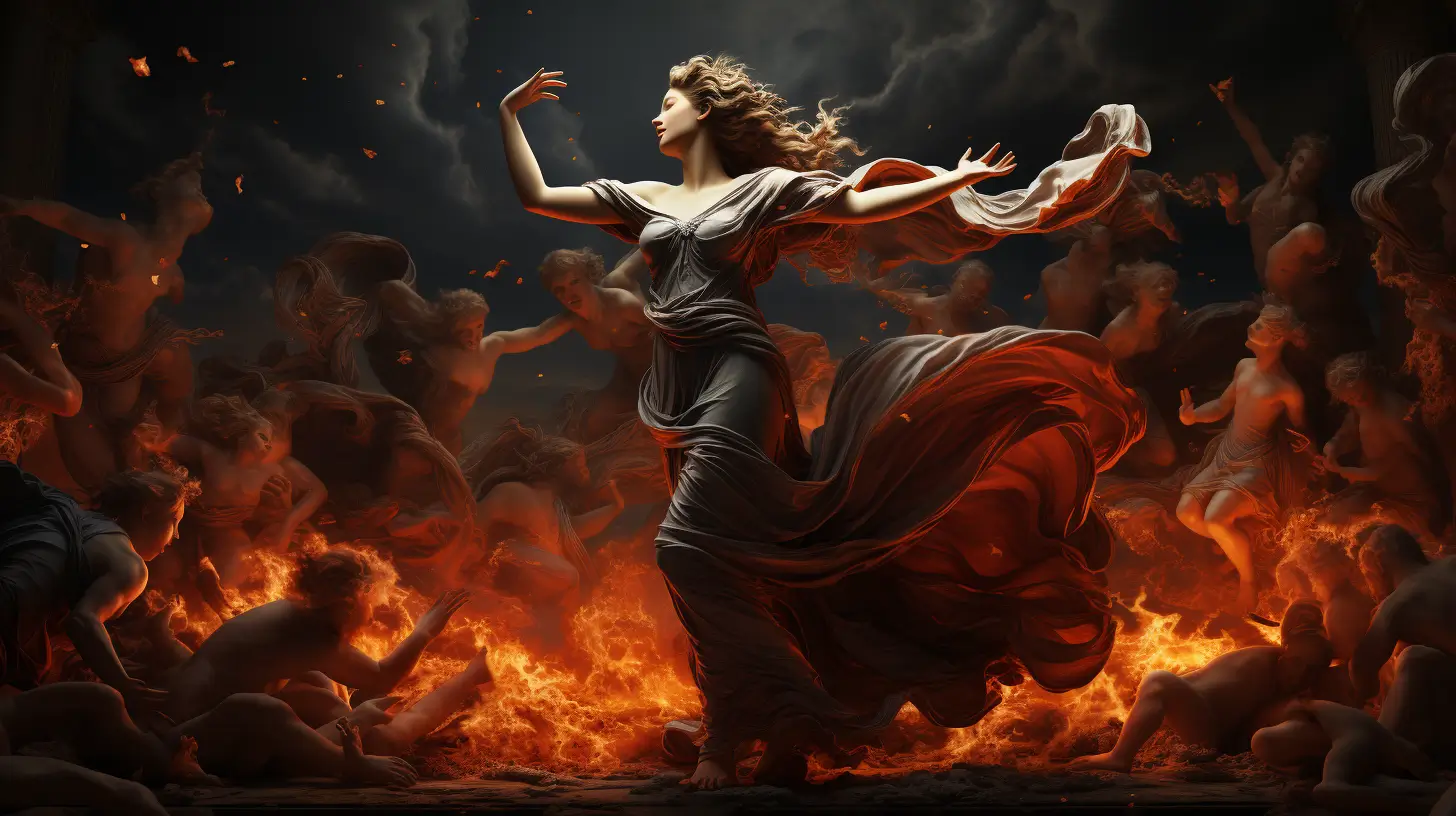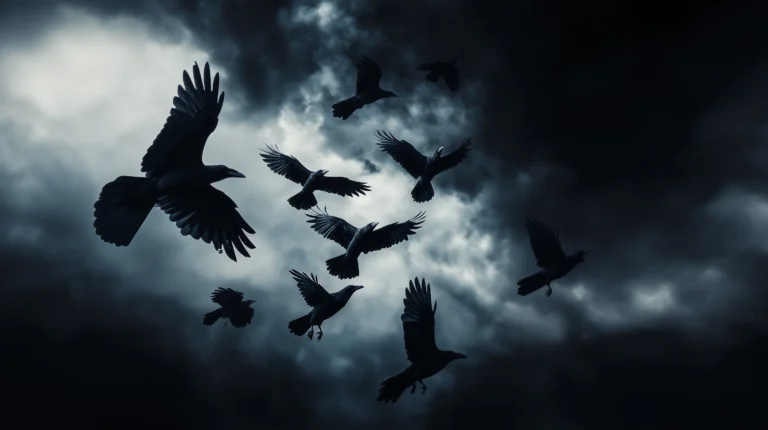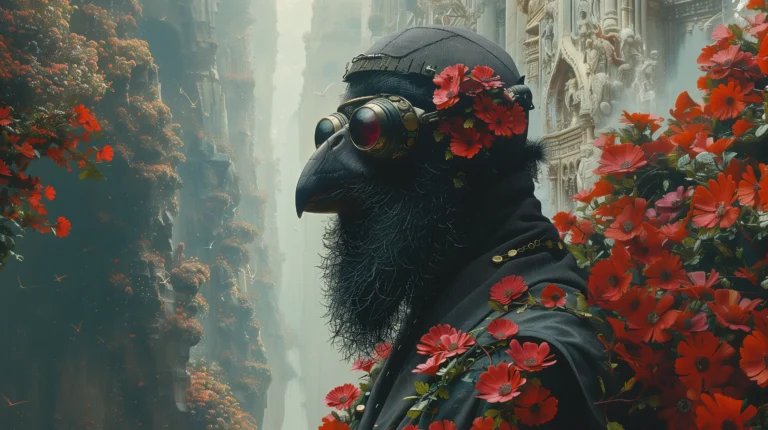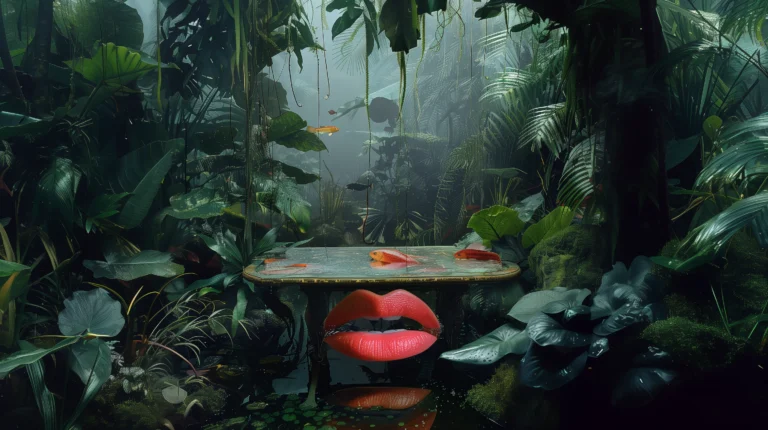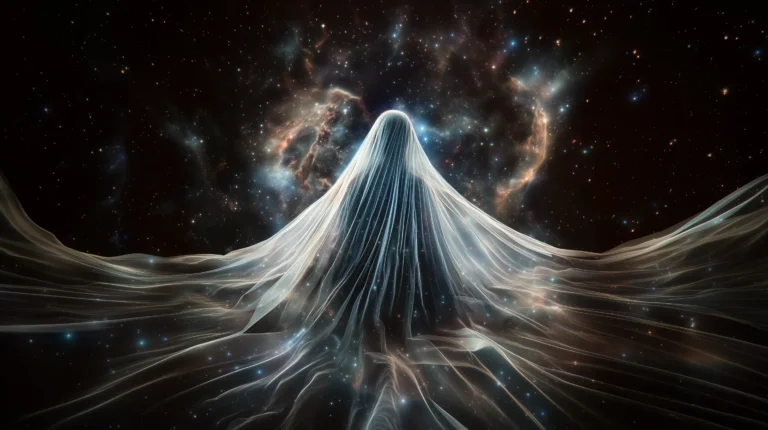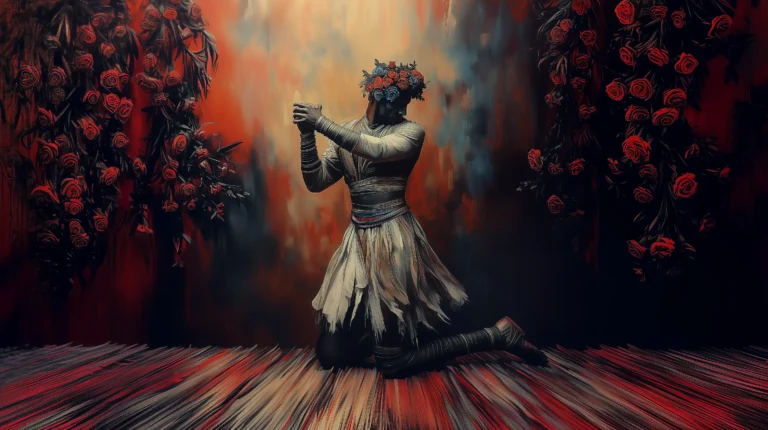The Dance of Logic and Soul
The Dance of Logic and Soul
The Shaman’s Way
In the labyrinth of human existence, two profound concepts guide our path: reason and meaning. These are not mere concepts, but rather the fundamental scaffolds upon which the edifice of human understanding is constructed. On one end, reason offers us a mechanical view of life, a lens to dissect and understand the universe’s intricate machinery. On the other, meaning propels us into the ethereal realm of spirituality, enabling us to transcend our worldly confines. However, in our pursuit of understanding, is it possible that the key lies not in favoring one over the other but in harmonizing both?
In the annals of human contemplation, the pendulum of thought has often swung between two poles: the empirical clarity of reason and the ethereal depths of meaning. These paradigms serve as the foundation upon which we build our understanding of existence, representing both the tangible and intangible dimensions of life. As the renowned philosopher Immanuel Kant once remarked,
“All our knowledge begins with the senses, proceeds then to the understanding, and ends with reason. There is nothing higher than reason.”
Yet, just as reason finds its pedestal in our minds, the age-old quest for meaning calls out to the human soul, reminding us of a world beyond the mechanistic. Victor Frankl, the psychiatrist and Holocaust survivor, astutely observed,
“Those who have a ‘why’ to live, can bear with almost any ‘how’.”
In the dynamic interplay of these perspectives lies a profound exploration of the human condition. Through reason, we attempt to dissect, categorize, and make sense of the cosmos around us. It is the anchor that grounds us to the physical reality. However, solely tethered to reason, life might risk becoming a sterile sequence of cause and effect. Meaning, on the other hand, offers a compass, guiding us towards purpose, significance, and spiritual fulfillment.
This guide delves deep into these two paradigms, unraveling the intrinsic value of both, while emphasizing the profound potential that arises from their harmonization. As we embark on this philosophical journey, let us remember the words of Albert Einstein:
“Science without religion is lame, religion without science is blind.”
It’s a testament to the importance of balancing the structured insights of reason with the soulful introspection of meaning.
At some point in their lives, every individual contemplates profound questions: “Is there more to life? What is my purpose? Why am I here, and what’s the point of all this effort?” It’s crucial to acknowledge from the outset that these questions don’t have universal answers. Ultimately, each person must forge their own meaning. Individuals face a choice: to adhere to established beliefs or to cultivate their own spiritual path, evolving over time.
Both options come with their own sets of benefits and drawbacks. Embracing established beliefs offers safety and simplicity, allowing one to navigate from point A to point B by following well-trodden paths. Conversely, those seeking to express their true selves must venture into the unknown, creatively blending old and new philosophies through experiences and meaningful coincidences. Regardless of the path chosen, the challenge lies in reconciling these beliefs with a rational understanding of the world.
It’s essential to recognize the limitations of science, religion, and personal spirituality; many aspects of existence remain unexplained. If someone views life purely as a mechanical process, devoid of anything beyond the physical world, that reflects their personal choice. However, it’s worth considering where such a viewpoint might lead.
This guide will explore the concepts of Reason and Spirituality before examining how to merge them for a balanced life. This synthesis is akin to the work of an alchemist, striving to harmonize all elements.
Reason: The Mechanical Lens
From the earliest days of philosophy, reason has been championed as the torch that illuminates the mysteries of existence. Thinkers like Descartes and Spinoza perceived the universe as a grand machine, its parts interacting in a cause-and-effect relationship, all governed by laws that reason could uncover.
In this view, everything— from the falling apple to human behavior— adheres to deterministic principles. If one understands the underlying laws, the universe unfolds like clockwork. There is order, predictability, and a sense of mastery that comes from this knowledge. This mechanistic perspective gave birth to the scientific revolution, leading to advancements in technology, medicine, and various other disciplines.
However, while the mechanical view offers clarity and control, it also has the potential to reduce life to mere equations, devoid of wonder or transcendence. If everything can be explained and predicted, where does that leave the human spirit?
As we traverse the intricate tapestry of human cognition, reason stands out as a beacon of clarity and structure. It’s the methodical architect of our understanding, crafting intricate blueprints of the world around us. Sir Isaac Newton, who arguably epitomizes the mechanistic view of the universe, once mused,
“Truth is ever to be found in simplicity, and not in the multiplicity and confusion of things.”
Through reason, life and the universe become decipherable, almost as if the cosmos itself operates like an intricate clock, each cog and gear falling into place with precision.
Descartes, another luminary in the realm of reason, declared,
“I think, therefore I am,”
encapsulating the essence of a world where existence is validated through logic and rational introspection. In this mechanical realm, events are chained in cause and effect, determinism rules, and predictability becomes the norm. The universe is not a chaotic abyss but a structured orchestration, where each note, each movement, follows a logical pattern.
Yet, while this perspective shines light on many mysteries, one might ponder whether it strips away the poetry of existence, rendering it a mere cold and impersonal machinery. As we delve deeper into the realm of reason, it’s imperative to remember the words of poet William Blake:
“If the doors of perception were cleansed everything would appear to man as it is, infinite.”
Even within the constraints of reason, there lies the potential for boundless wonder.
Meaning: The Spiritual Odyssey
Enter the realm of meaning, the antidote to the potentially soulless void of pure reason. Whereas reason seeks to explain, meaning seeks to feel and experience. The ancient Greeks, for instance, had two words for knowledge: “episteme” (empirical knowledge) and “gnosis” (intuitive or spiritual knowledge). Meaning relates more closely to gnosis, pointing towards a knowledge that is felt in the heart and soul rather than deduced by the mind.
Spirituality, in its many forms, emphasizes the interconnectedness of all things and the idea that there’s a higher purpose or design. It compels individuals to ask questions like,
“Why am I here?” or “What is my purpose?”
Such inquiries elevate human existence beyond the mechanical and into the realm of the divine or transcendental.
Yet, relying solely on spiritual interpretations without grounding can lead to illusions or detachment from reality. Without reason’s guiding hand, one may wander endlessly in the vast ocean of metaphysical speculation.
In the grand theater of human consciousness, while reason plays the script’s meticulous director, meaning stands as the emotive and impassioned lead actor. It is the whisper of the cosmos, beckoning us to look beyond the tangible and dive deep into the vast ocean of the soul’s yearnings. The great philosopher Plato once posited,
“The measure of a man is what he does with power.”
In the pursuit of meaning, this power is not of dominion or control, but of understanding one’s place in the grand narrative of existence.
Throughout ages, luminaries have sought this elusive essence. The renowned poet Rumi eloquently expressed,
“What you seek is seeking you.”
Meaning is not just an intellectual exercise; it is an intimate dance of the soul, a yearning for connection, purpose, and transcendence. It asks not how the world functions, but why it exists and what role we play in its grand design.
However, the voyage into meaning is not without its challenges. Venturing beyond the empirically known can sometimes lead us into the mists of vagueness and ambiguity. Yet, it is in these mists that the human spirit often finds its true compass. The mystic Khalil Gibran wisely observed,
“Out of suffering have emerged the strongest souls; the most massive characters are seared with scars.”
In the quest for meaning, there lies not just answers but a deeper resonance with the universe, a harmonious symphony that elevates life from mere existence to profound significance.
Harmonizing Both Views
The dichotomy between reason and meaning is, at its core, a manifestation of the eternal struggle between the head and the heart. Yet, as history has shown, neither perspective alone offers a complete understanding of our existence.
Incorporating both the mechanical and spiritual views allows for a more holistic comprehension of life. While reason enables us to understand and navigate the world effectively, meaning instills that understanding with purpose and passion.
Consider the metaphor of a musical instrument. Reason provides the technical knowledge to craft and play the instrument, but meaning offers the soul-stirring melodies that make the instrument truly sing.
Philosophers like Carl Jung believed in the integration of these contrasting viewpoints. He emphasized the importance of balancing logos (logic, reason) and eros (emotion, intuition) for a complete human experience.
In the grand composition of human understanding, the notes of reason and the melodies of meaning often play their tunes, distinct and resounding. However, the true essence of their beauty is realized when they come together, harmonizing in a symphony that transcends individual rhythms. As Aristotle wisely stated,
“The more you know, the more you realize you don’t know.”
This sentiment captures the intrinsic value of merging the clarity of reason with the depth of meaning.
Consider a masterful painting: reason sketches the outline, offering form and structure, while meaning infuses it with colors, emotions, and nuances. Together, they create a masterpiece that speaks both to the intellect and the soul. This confluence reminds one of the words of Blaise Pascal,
“The heart has its reasons which reason knows not.”
While reason offers us the tools to navigate the tangible world, meaning provides the compass that points us towards the intangible, the profound, the sublime.
Yet, harmonizing these views is no simple task. It requires a delicate balance, a dance that respects the strengths and limitations of both paradigms. The philosopher Friedrich Nietzsche reflected upon this interplay, asserting,
“He who fights with monsters should be careful lest he thereby become a monster. And if you gaze long enough into an abyss, the abyss will gaze back into you.”
This caution serves as a reminder that an over-reliance on either perspective can lead to incompleteness. Instead, by embracing and intertwining reason and meaning, we craft a tapestry of understanding that is both rich in detail and depth, resonating with the vast spectrum of the human experience.
Bridging Two Realms
Life, in all its complexity, cannot be reduced to mere equations or metaphysical musings. Just as a bird requires both wings to fly, the human spirit needs both reason and meaning to soar. By embracing and integrating these dual aspects of our nature, we not only enrich our understanding of the universe but also elevate our place within it.
As we reflect upon the intricate dance between reason and meaning, we come to recognize the essential duality that defines human understanding. This interplay, age-old and profound, reminds us that to grasp the fullness of life, we must employ both the analytical rigor of the mind and the deep intuitions of the heart. The words of the renowned physicist and philosopher, Sir Arthur Eddington, come to mind:
“Something unknown is doing we don’t know what.”
It captures the essence of our journey—where reason constructs the pathways to knowledge, and meaning infuses those pathways with soulful purpose.
The mechanical view, grounded in reason, provides us with the tangible mechanisms of existence, ensuring that we remain rooted in the empirical world, understanding its patterns and principles. Yet, it is the spiritual odyssey, fueled by the quest for meaning, that elevates this understanding, allowing us to transcend mere observation and touch the ethereal aspects of existence.
In this harmonization lies not just a philosophical exercise, but a practical guide for life. By navigating the world with both the compass of reason and the map of meaning, we ensure a journey that is both enlightening and enriching. It’s a journey that doesn’t merely seek to understand the world but to find one’s place within it, imbuing life with purpose and passion.
In the intricate tapestry of human experience, the journey toward understanding and integrating Reason and Spirituality is both profound and transformative. At the heart of this quest lies the ancient practice of Shamanism, a spiritual tradition that has, for millennia, offered insights into the deep connections between the natural world and the human spirit. Shamanism is not merely a belief system but a way of engaging with the world, where practitioners—shamans—serve as intermediaries between the physical and the spiritual realms. Through rituals, meditative journeys, and the guidance of spirit allies, shamans traverse the unseen, delving into the subconscious to retrieve knowledge and healing that benefit both the individual and their community.
Shamans understand the delicate balance between diving deep into the waters of the subconscious, connecting with spirits and ancestral wisdom, and returning to consciousness with insights (the boon) that have practical applications in the material world. This process mirrors the alchemical endeavor of reconciling the seemingly disparate aspects of existence—Reason and Spirituality—into a cohesive whole. It’s a reminder that the pursuit of knowledge and the quest for spiritual understanding are not mutually exclusive but are complementary facets of the human desire to comprehend our place in the universe.
Joseph Campbell, who illuminated the power of myths and their role in human society, famously encouraged us to confront our fears to find the treasures we seek. He stated,
“The cave you fear to enter holds the treasure you seek.”
highlighting the importance of embracing the unknown in our quest for meaning. This wisdom is particularly relevant to the shamanic journey, where the venture into the shadowy realms of the subconscious can reveal profound truths and transformative insights.
Echoing the insights of mystics and poets, Rumi’s profound guidance,
“Your task is not to seek for love, but merely to seek and find all the barriers within yourself that you have built against it.”
offers a transformative perspective on our journey toward self-discovery and integration. This wisdom serves as a powerful reminder that our quest to harmonize Reason and Spirituality is deeply rooted in the work of dismantling internal obstacles and opening our hearts to the essence of existence. The path to understanding and unity is not about seeking something external but about introspection and removing the barriers we’ve constructed against the universal force of love.
The journey towards blending the analytical with the spiritual becomes a process of uncovering and addressing the resistances and fears that hinder our connection to ourselves, to others, and to the cosmos. This alignment is not merely a personal or isolated quest but a collective endeavor that resonates with the foundational truth of our interconnectedness.
As individuals on this path, we are encouraged to live authentically, embracing our unique expressions without fear or guilt. In doing so, we align ourselves with our true purpose and contribute to the collective journey towards understanding and harmony. By loving ourselves—acknowledging our worth and embracing our inner light—we set the foundation for extending that love outward, creating ripples of positivity and connection.
For those navigating the uncharted territories of their own spirituality, drawing inspiration from the Tarot’s Queen and King of Cups can be incredibly powerful.
The Queen and King of Cups in the Tarot deck embody rich and nuanced archetypes that speak deeply to the journey of personal and spiritual development. These figures are not just characters but symbols of the profound mastery over the emotional and intuitive realms of our being.
The Queen of Cups represents the pinnacle of emotional awareness and intuition. She is often depicted as a nurturing figure, holding her cup—a symbol of her understanding and empathy towards the emotional undercurrents that influence us all. Her presence in a reading can signify a time of introspection and emotional growth, urging an individual to explore the depths of their feelings and to harness their empathetic and intuitive capacities. The Queen encourages us to approach our inner world and the world around us with kindness, understanding, and an open heart, reminding us of the strength that lies in vulnerability and emotional intelligence.
The King of Cups, on the other hand, embodies the integration of emotional depth with the maturity to act wisely upon those emotions. He is a figure of balance, capable of navigating the tumultuous seas of the subconscious without being overwhelmed. This archetype suggests a mastery over one’s emotions, not through suppression but through understanding, allowing for compassionate leadership and decision-making. The King’s presence encourages the development of a balanced emotional and intellectual approach to life’s challenges, advocating for a leadership style that is informed by empathy and emotional intelligence.
Drawing inspiration from the Queen and King of Cups can be incredibly empowering for those navigating the complexities of their spirituality and personal growth. These archetypes teach us the value of understanding our emotions, the power of intuition, and the importance of maintaining composure and compassion in the face of adversity. They remind us that true wisdom comes from a balanced approach to life, integrating our emotional depth with thoughtful action.
In this journey of self-discovery and spiritual exploration, it is essential to seek guidance from within, from the world around us, and from the vastness of the universe. However, it’s crucial to remember that while we may draw inspiration and support from various sources, we should not elevate any entity or concept to the status of ultimate worship. The essence of divinity, the absolute reality that transcends our understanding, remains ineffable and unknowable. Rumi eloquently captures this sentiment when he says,
“Silence is the language of God; all else is poor translation.”
In seeking connection with this profound mystery, it is in stillness and silence that we come closest to experiencing the divine. This approach encourages a personal and direct experience of the spiritual, free from the constraints of dogma, inviting us to explore the infinite within the quietude of our being.
This exploration of Reason and Spirituality, inspired by the principles of Shamanism, underscores the complex yet beautiful dance between the analytical and the intuitive, the tangible and the ethereal. It is an alchemical journey, where the fusion of disparate elements leads to the emergence of a new understanding—a holistic vision of existence where every aspect of our being finds its place. In this synthesis, we do not merely find a balance but a profound union of head and heart, leading us to the soul of existence. Here, in the alchemical cauldron of our experiences, we discover the essence of life itself, transforming our understanding and enabling us to live with a deeper sense of purpose and interconnectedness.
The Alchemy of Spirit and Reason
The Shaman’s Way
In the tapestry of night and day, where dreams and logic play,
A journey deep within the soul, where heart and mind hold sway.
Through the mists of time and space, a path both old and new,
Where shaman’s drum and sage’s grace, weave insights ever true.
In shadowed caves and silent groves, where mystics’ whispers roam,
We seek the treasures deep within, the light within the gloam.
For Joseph Campbell’s wisdom told, in fear the treasure lies,
And Rumi’s words, like threads of gold, illuminate the skies.
“Seek not for love,” the poet said, “but barriers within,”
A quest to tear down walls of dread, and let the heart begin.
To blend the streams of head and heart, in harmony’s sweet dance,
Where reason’s light and spirit’s art, in sacred union, prance.
In Tarot’s realm, the Queen and King of Cups their secrets share,
Masters of the heart’s deep well, in life’s unending fair.
One with empathy’s tender gaze, the other, wisdom’s poise,
Together they navigate life’s maze, with grace and balanced voice.
So on we walk, this mortal coil, in search of meaning’s flame,
In silent woods or crowded toil, the inner call the same.
In stillness, whispers of the divine, in every rustling leaf,
In silence, we touch the sublime, beyond belief or grief.
For in the quiet, we understand, the language of the stars,
The soul’s own song, a melody, transcending earthly bars.
A journey not of outward sight, but inward, deep and vast,
Where every soul, in its own right, finds peace and love at last.
This alchemy of heart and mind, a dance of sun and moon,
In every one of us, we find, a harmony in tune.
So venture forth, with courage bright, in your unique sojourn,
In the alchemy of spirit and reason, let your true self be born.

